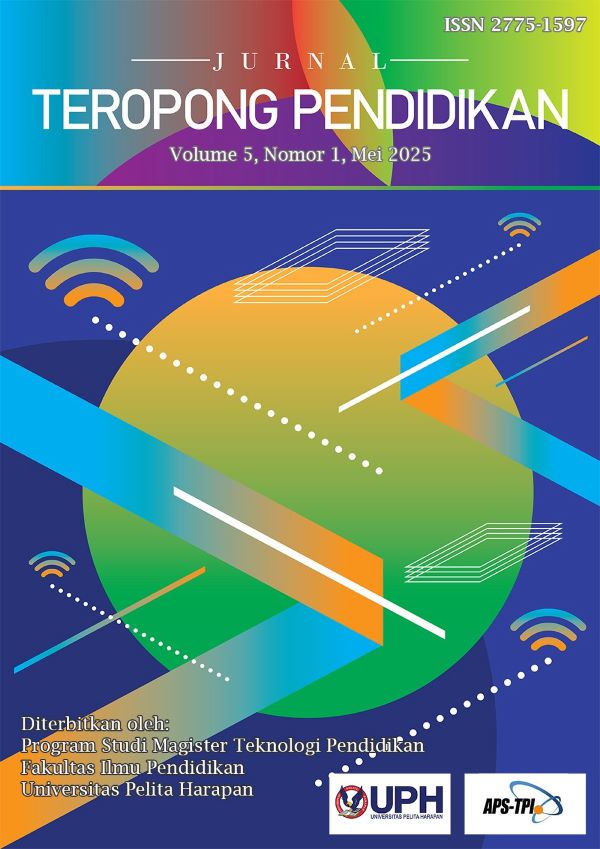Pengaruh Penggunaan Media Sosial terhadap Kreativitas Peserta Didik di Jurusan Fesyen Desain dan Kreasi ESMOD Jakarta [The Influence of Social Media Usage on Student Creativity in the Fashion Design and Creation Department, ESMOD Jakarta]
DOI:
https://doi.org/10.19166/jtp.v5i1.9536Abstract
Technological advancements have introduced the concept of 21st century learning that integrates technology to promote critical and creative thinking. Data shows that 167 million people in Indonesia use social media, with 41.9% aged 13-24 years old. This study aims to analyze the influence of social media use on students' creativity in learning and identify the most influential platforms, with a focus on Instagram and TikTok. This study uses quantitative research methods with correlation data analysis techniques, correlation coefficients, and categorization. This research uses an instrument in the form of a questionnaire that was distributed to 50 fashion design students at ESMOD Jakarta. The results show that the use of social media has a positive influence on the creative process of students, although the influence is very weak which can be seen from the beta coefficient (β) value of 0.09 and the regression value of 0.13, as well as the low determination coefficient (R²) of 0.02. In addition, the results of the T-count value < the T-table (0.52 < 1.68) show that there is not enough evidence to state that there is a significant difference in creativity between Instagram and TikTok users. So, it can be concluded that although social media has a very weak positive effect on students' creativity, there is no significant difference between Instagram and TikTok users. Both platforms contribute almost equally, and other factors may play a more significant role in boosting students' creativity.
References
Ali, M. M. (2022). Metodologi penelitian kuantitatif dan penerapan Nya dalam penelitian. JPIB: Jurnal Penelitian Ibnu Rusyd, 1(2), 1–5. https://ojs.stai-ibnurusyd.ac.id/index.php/jpib/article/view/86
Budenz, A., Klassen, A., Purtle, J., Yom-Tov, E., Yudell, M., & Massey, P. (2022). If I was to post something, it would be too vulnerable: University students and mental health disclosures on Instagram. Journal of American College Health, 70(2), 615–624. https://doi.org/10.1080/07448481.2020.1759608
Budiman, B. (2022). Pemanfaatan media sosial sebagai media pembelajaran Bahasa Indonesia. EUNOIA: Jurnal Pendidkan Bahasa Indonesia, 2(2), 150–156. http://dx.doi.org/10.30821/eunoia.v2i2.2098
Faradiba, Y., Jahja, Y., & Khasanah, A. (2022). Pengembangan kreativitas anak melalui kurikulumplus. Jurnal Pendidikan Indonesia, 3(10), 870–878. https://doi.org/10.59141/japendi.v3i10.654
Hamzah, D. A. (2021). Metode penelitian kualitatif rekontruksi pemikiran dasar serta contoh penerapan pada ilmu pendidikan, sosial & humaniora. CV Literasi Nusantara Abadi.
Kemp, S. (2023, February 9). Digital 2023: Indonesia. DATAREPORTAL. https://datareportal.com/reports/digital-2023-indonesia
Mulia, T. C., & Rahayu, W. (2023). Creative thinking in Mathematics. PRIMA: Jurnal Pendidikan Matematika, 7(2), 213–225. http://dx.doi.org/10.31000/prima.v7i2.8528
Perssela, R. P., Mahendra, R., & Rahmadianti, W. (2022). Pemanfaatan media sosial untuk efektivitas komunikasi. Jurnal Ilmiah Mahasiswa Kuliah Kerja Nyata, 2(3), 650–656. https://doi.org/10.36085/jimakukerta.v2i3.4525
Putra, Y. D., & Junita, D. (2024). Realitas keterlibatan gen Z dalam media sosial Tiktok perspektif sosiokultural. INTERCODE: Jurnal Ilmu Komunikasi, 4(1), 33–55. https://doi.org/10.36269/ire.v4i1.2746
Sangadji, F. A. P., Fitri, A. C. S., Sitanggang, D. A., Hidayat, R., & Ikaningtyas, M. (2024). Peran media sosial tiktok sebagai platform untuk pengembangan bisnis di era digital. KARYA: Jurnal Pengabdian Kepada Masyarakat, 4(1), 143–149. https://jurnalfkip.samawa-university.ac.id/KARYA_JPM/article/view/683
Sardianah, S., Muslimin, M., & Salam, S. (2021). Pengaruh penerapan pendekatan kontekstual dan kreativitas siswa terhadap kemampuan menulis puisi di SMP Negeri 1 Atinggola. Jurnal Penelitian Pendidikan Bahasa Indonesia, 1(1), 13–20. http://dx.doi.org/10.37905/rjppbi.v1i1.537
Situmorang, S. M. S., Rustaman, N. Y., & Purwianingsih, W. (2020). Identifikasi kreativitas peserta didik SMA dalam pembelajaran levels of inquiry pada materi system pernapasan melalui asesmen kinerja. Didaktika Biologi: Jurnal Penelitian Pendidikan Biologi, 4(1), 35–43. https://doi.org/10.32502/dikbio.v4i1.2287
Statista. (2021). Global social networks ranked by number of users. Statista. https://www.statista.com/statistics/272014/global-social-networks-ranked-by-number-of- users
Sugiyono. (2021). Metode penelitian kuantitatif, kualitatif, dan R&D. Indonesia, Bandung: Alfabeta.
Sutedja, H. A., & Ahmaddien, I. (2020). Pengantar statistika. Indonesia, Bandung: Widina Bhakti Persada.
Syifa, S. F., Istirohmah, A. N., Lestari, P., & Azizah, M. N. (2023). Dampak penggunaan media sosial terhadap prestasi belajar peserta didik. BELAINDIKA: Pembelajaran dan Inovasi Pendidikan, 5(1), 21–27. http://dx.doi.org/10.52005/belaindika.v5i1.100
Thabroni, G. (2022, April 17). Konsep pendidikan abad 21: Prinsip, kompetensi, keterampilan, dsb. serupa.id. https://serupa.id/konsep-pendidikan-abad-21/
Tuto, M. F., Fransiskus, A., & Iswahyudi, D. (2024). Pengaruh pemanfaatan media sosial (youtube) terhadap kreativitas belajar peserta didik pada mata pelajaran Pendidikan Pancasila di SMP Negeri 17 Malang. JAMAPEDIK: Jurnal Manejemen, Akuntansi dan Pendidikan, 1(2), 241–250. https://doi.org/10.59971/jamapedik.v1i2.50
Veranita, M., Susilowati, R., & Yusuf, R. (2021). Pemanfaatan platform media sosial instagram sebagai media promosi industri kuliner saat pandemi COVID-19 (studi kasus pada akun @kolakcampurkolaku). Jurnal Bisnis dan Kewirausahaan, 17(3), 279–290. https://doi.org/10.31940/jbk.v17i3.279-290
Downloads
Published
Issue
Section
License
Copyright (c) 2025 Risanti Intan Al Baluni, Gavrielin Ginarid, Sesilia Fajar Handayani

This work is licensed under a Creative Commons Attribution-ShareAlike 4.0 International License.
Authors who publish with this journal agree to the following terms:
1) Authors retain copyright and grant the journal right of first publication with the work simultaneously licensed under a Creative Commons Attribution License (CC-BY-SA 4.0) that allows others to share the work with an acknowledgement of the work's authorship and initial publication in this journal.
2) Authors are able to enter into separate, additional contractual arrangements for the non-exclusive distribution of the journal's published version of the work (e.g., post it to an institutional repository or publish it in a book), with an acknowledgement of its initial publication in this journal.
3) Authors are permitted and encouraged to post their work online (e.g., in institutional repositories or on their website). The final published PDF should be used and bibliographic details that credit the publication in this journal should be included.





